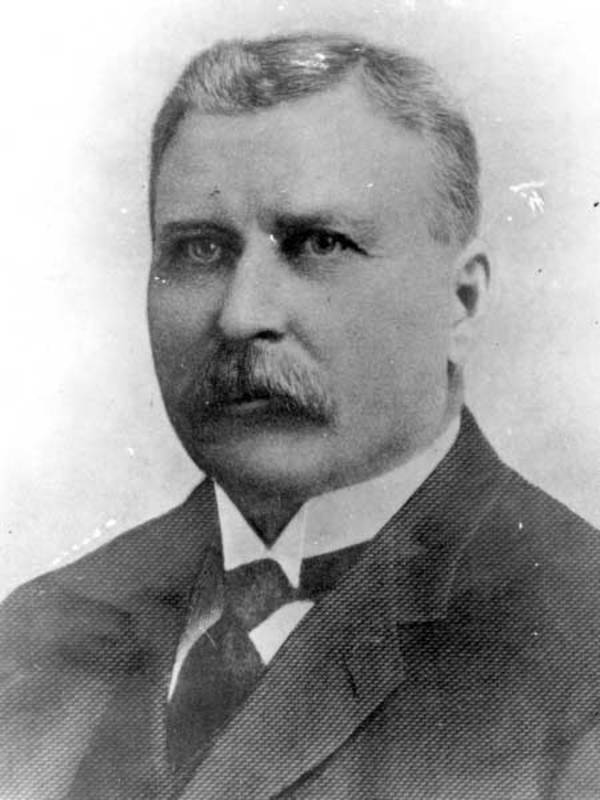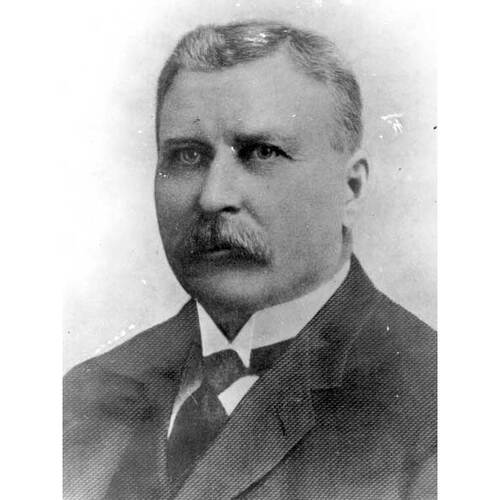As part of the funding agreement between the Dictionary of Canadian Biography and the Canadian Museum of History, we invite readers to take part in a short survey.

Source: Link
McARTHUR, JOHN DUNCAN, railway contractor, lumberman, and businessman; b. 25 June 1854 in Lancaster, Upper Canada; m. there January 1889 Mary McIntosh; they had no children; d. 10 Jan. 1927 in Winnipeg.
John Duncan McArthur received his schooling in Glengarry County and spent several years on his father’s farm before moving west in 1879. He found work with a special “flying gang” that maintained Winnipeg’s first rail connections with the outside world, via St Paul and Minneapolis, Minn.
When the Canadian Pacific Railway syndicate began construction of its main line in 1881, McArthur obtained a number of subcontracts, first in heavy rock cutting between Winnipeg and Fort William (Thunder Bay, Ont.) and then with contractors building the line on the prairies. After 1883 he secured several contracts from James Ross* for work on the mountain section of the CPR.
In 1888 McArthur achieved notoriety when he signed a contract for the construction of the Red River Valley Railway from Winnipeg to Emerson, Man. This railway had been chartered by the Manitoba government of John Norquay* the previous year and was to run south to join with the Northern Pacific Railroad. Provincial politicians hoped that the creation of a line to compete with the CPR would result in significantly lower freight charges. The federal government of Sir John A. Macdonald* disallowed the provincial legislation, but the Manitoba government proceeded with construction of the railway, which was leased to a subsidiary of the Northern Pacific, the Northern Pacific and Manitoba. There were several tense and colourful confrontations between CPR crews under superintendent William Whyte*, supported by the federal government, and McArthur’s construction workers, who were reinforced by specially sworn provincial constables, over the right of the Manitoba railway to cross the CPR line. A snowstorm halted construction in the fall of 1888. The matter was referred to the courts, which decided in favour of Manitoba, and construction resumed in 1889. In the midst of this turmoil McArthur returned to his native Glengarry County, where he married Mary McIntosh.
There was a lull in Canadian railway construction from 1889 until 1897, when the CPR secured federal subsidies for the building of a branch line from Lethbridge, Alta, to Nelson, B.C., popularly known as the Crow’s Nest Pass Railway. McArthur obtained the contract. His work satisfied CPR officials, but got him into serious difficulties because of widely publicized allegations regarding his treatment of his crews. Press reports and complaints from social reformers, often based on first-hand accounts by disgruntled workers, suggested that he and other contractors on the line failed to take appropriate safety measures or to provide suitable living conditions and medical care (in spite of the fact that deductions were made from workers’ pay to cover the cost of medical treatment). The incidence of accidents and illness lent credence to these complaints and resulted in the appointment in 1898 of a federal commission of inquiry chaired by judge Calixte-Aimé Dugas. The commission gathered evidence of dubious employment practices in McArthur’s business, and in the railway contracting business generally. It made numerous recommendations, but no charges seem to have been laid.
After completing work on the Crow’s Nest line, McArthur obtained a contract from the promoters of the Canadian Northern Railway, William Mackenzie and Donald Mann*. Attempts to provide links at Edmonton between their lines north and south of the North Saskatchewan River resulted in physical confrontations between CPR employees and McArthur’s construction workers which were reminiscent of those in Manitoba.
In 1903 the federal government of Sir Wilfrid Laurier* introduced legislation calling for a second transcontinental railway, to be constructed in two sections. When the Grand Trunk Pacific Railway Company [see Charles Melville Hays*], which was to build the section from Winnipeg to the Pacific, began construction on the prairies, McArthur secured some work, while completing old contracts and negotiating new ones with the Canadian Northern and the CPR. The federal government had agreed to build, and then lease to the GTPR, the eastern section from Winnipeg to Moncton, N.B. McArthur’s most profitable and most controversial contract, signed in 1905, was for construction of the critically important mileage from Winnipeg to Superior Junction, in northern Ontario. His bid, which left blank 48 of the 101 items on the application form, has been described by CPR historian George Roy Stevens as “grossly irregular.” The incomplete bid was for $33,073 per mile, which was three per cent below the costs estimated by the government. In the end he was paid $78,745 per mile, this in spite of the fact that he failed to meet construction deadlines. Difficulties caused by muskeg and heavy rock work, and hence changes in the classifications of work done, were blamed for the higher costs. His failure to complete the work on time proved extremely expensive for the Grand Trunk Pacific because the entire line could not be opened for through traffic as quickly as originally planned. Few railways in Canadian history have as sorry a record of government incompetence and alleged political corruption and patronage as does the National Transcontinental Railway; McArthur’s contract, completed in August 1910, is often cited as an example of what went wrong.
The delays in completing the route from Winnipeg to Superior Junction were in part due to the fact that McArthur was at the same time working on a number of smaller contracts with the other major railways which exacted more stringent penalties if work was not completed on time. In addition, he took up two large new projects. The first of these involved railways in northern Alberta, for which the provincial government of Arthur Lewis Watkins Sifton was willing to provide generous financial assistance. In 1911 McArthur gained control of the Edmonton, Dunvegan and British Columbia Railway, which was to provide service to the Peace River country, and he became both its promoter and its contractor. In addition, in 1913 he obtained a contract to build the Alberta and Great Waterways Railway. Owing to the exigencies of World War I, McArthur was unable to raise the money needed to complete construction of the EDBCR. The Alberta government was forced to take it over in 1920, but not before it had earned the nickname Extremely Dangerous and Badly Constructed. McArthur got paid for the work completed and the materials and equipment left behind. The problems documented by the commission of 1898 were also evident on these later contracts, although they received much less publicity.
While still busy building the line from Winnipeg to Superior Junction and already heavily committed in northern Alberta, McArthur signed another large and difficult contract, this time to build from The Pas, Man., to Port Nelson on the western shore of Hudson Bay. This too was a federal government project, sanctioned by the Liberals just before their defeat in the election of 1911. The new Conservative government of Robert Laird Borden* first stopped, but then approved and extended the terms of McArthur’s contract. At the close of the construction season of 1914, rails had been laid on the first 214 miles of the new line, but the financial difficulties of wartime, a fire which destroyed McArthur’s track-laying outfit, and growing uneasiness regarding the suitability of the proposed harbour facilities at Nelson resulted in a halt when construction reached mile 333 in December 1917. In 1919 the federal government cancelled the contract. Canadian National Railways took possession of McArthur’s remaining equipment and supplies for use elsewhere on their system. A decade later the route was changed and the Hudson Bay Railway was built to Churchill, Man., in 1930–31.
McArthur was also a promoter of lumbering operations and the manufacture of pulp and paper. Early in his career he had secured large timber leases in the Birtle and Lac du Bonnet regions of Manitoba. Later he obtained similar rights in British Columbia. Initially he engaged mainly in lumbering operations, but toward the end of his career he became active in the pulp and paper industry. He was instrumental in the organization of the Manitoba Pulp and Paper Company, which at the time of his death had almost completed construction of a huge mill and hydroelectric generating plant at Pine Falls. He was also interested in a second large pulp and paper mill near Prince George, B.C., was involved in a smaller mining and lumbering operation near Moyie, B.C., and had extensive real estate holdings, particularly in the Winnipeg area.
After unsuccessfully seeking treatment in the United States for pernicious anaemia and related complications, John Duncan McArthur returned to Winnipeg and died there early in 1927. He was one of western Canada’s greatest railway contractors, having built over 2,833 miles of track, but he was also one of its most controversial.
Manitoba Free Press, 11 Jan. 1927. J. A. Eagle, “J. D. McArthur and the Peace River Railway,” Alberta Hist. (Calgary), 29 (1981), no.4: 33–39. H. A. Fleming, Canada’s Arctic outlet: a history of the Hudson Bay Railway (Berkeley, Calif., 1957; repr. Westport, Conn., 1978). T. D. Regehr, The Canadian Northern Railway, pioneer road of the northern prairies, 1895–1918 (Toronto, 1976); “The National Policy and Manitoba railway legislation, 1879–1888” (ma thesis, Carleton Univ., Ottawa, 1963). G. R. Stevens, Canadian National Railways (2v., Toronto and Vancouver, 1960–62). A. B. Woywitka, “Strike at Waterways,” Alberta Hist. Rev. (Calgary), 20 (1972), no.4: 1–5.
Cite This Article
Theodore D. Regehr, “McARTHUR, JOHN DUNCAN,” in Dictionary of Canadian Biography, vol. 15, University of Toronto/Université Laval, 2003–, accessed March 29, 2025, https://www.biographi.ca/en/bio/mcarthur_john_duncan_15E.html.
The citation above shows the format for footnotes and endnotes according to the Chicago manual of style (16th edition). Information to be used in other citation formats:
| Permalink: | https://www.biographi.ca/en/bio/mcarthur_john_duncan_15E.html |
| Author of Article: | Theodore D. Regehr |
| Title of Article: | McARTHUR, JOHN DUNCAN |
| Publication Name: | Dictionary of Canadian Biography, vol. 15 |
| Publisher: | University of Toronto/Université Laval |
| Year of revision: | 2005 |
| Access Date: | March 29, 2025 |



